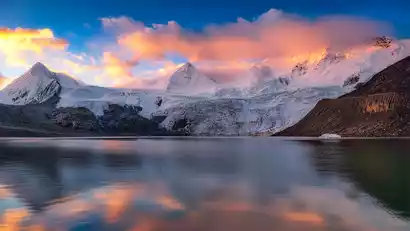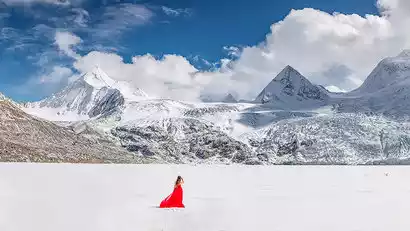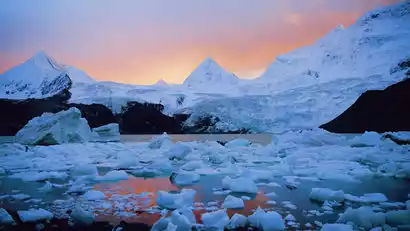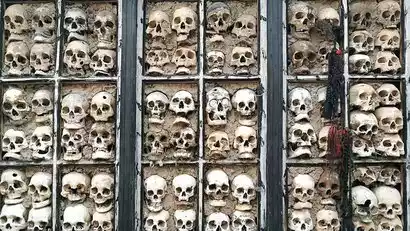Day 1 Various locations → → Lijiang ★ Gathering day
All day
Today is the full-day meeting day in Lijiang. Please book your flights/train tickets in advance. Upon arrival at the designated meeting hotel, please provide your "China-TravelNote + Name" to check in. After arranging your accommodations, you can freely photograph Lijiang Dayan Old Town and acclimate to the plateau climate. Alternatively, you can visit Qingxi Reservoir to capture the reflection of Jade Dragon Snow Mountain at sunset. After dark, you can visit the Lion Rock Observation Deck in Lijiang to capture the bustling nightscape of Dayan Old Town and capture the vibrant life of the ancient city.


Day 2 Lijiang → Shangri-La → Feilai Temple
·morning
We woke up early in the morning and headed to Qingxi Reservoir to wait for the sunrise over Jade Dragon Snow Mountain, capturing the moment when the first ray of sunlight illuminated the peak of the snow-capped mountain.
We then drove off, passing Xiaozhongdian Ranch and arriving in Shangri-La. We took some free time to create and photograph in Dukezong Ancient Town (we recommend visiting Guishan Park, high up in Dukezong, where you'll find a massive, gilded copper prayer wheel. It's 21 meters high and weighs 60 tons, a Guinness World Record entry).
·afternoon
In the afternoon we arrived at Moon Bay and took photos of the magnificent First Bend of the Jinsha River.
We will then pass through the Baima Snow Mountain Tunnel and reach Wunongding, a place with a wide view of Deqin County. The Meili Snow Mountain across from us is uninterrupted, with Feilaisi Village at the foot of the snow-capped mountains and the Lancang River Valley all within sight. From here, we will photograph the panoramic sunset view of the Meili Snow Mountain.
After the afterglow of the sunset faded away, we continued heading north and stayed at Feilai Temple at night.


Day 3 Feilai Temple → Yanjing → Mangkang
·morning
In the morning, we'll head to the observation deck to capture the golden glow of the Meili Snow Mountain. Kawagebo and Mentsumu, illuminated by the golden light, are a breathtaking sight. Afterward, we'll return to our hotel.
After breakfast, we'll sail upstream along the Lancang River, crossing the Yunnan-Tibet boundary marker and officially entering Tibet. Soon, we'll arrive at Yanjing, the first small town in Tibet. Here, we'll have lunch. China-TravelNote will offer a complimentary bowl of Yanjing Jiajia Noodles, a local specialty.
·afternoon
In the afternoon, we headed to the [Gada Millennium Ancient Salt Fields] to photograph the original and well-preserved manual salt-drying method, and then crossed the Hongla Mountain National Nature Reserve to photograph the Tha Nian Tha Weng Snow Mountain Group.
Overnight in Mangkang County.


Day 4 Mangkang → Qamdo
·morning
After breakfast we set off in good time, passing through Zhiri Pass (4790 meters above sea level, with a short stop and a quick pass), and photographing the alpine meadows.
·afternoon
In the afternoon, we headed to Qamdo's Jampa Ling Monastery (the focal point of today's photography). The temple embodies a profound faith and rich cultural heritage, with red earth, red walls, and red-robed monks. Entering the temple, we were greeted by a breathtaking view of the numerous monks seated within the high-walled courtyard and the spacious Buddhist hall. (Please be sure to respect the temple's customs and avoid offending the monks.)
That night, we'll stay in Qamdo, where we'll have free time at our leisure. This is a major city in eastern Tibet, so if you're still energetic, you can meet up and take photos of Qamdo's nightscape.


Day 5: Qamdo → Zizhu Monastery → Dingqing
·morning
We set off after breakfast and passed by Kamado Pagoda Forest Temple, an ancient building built more than 800 years ago. It still stands tall after going through baptisms. We stopped here to take photos.
·afternoon
In the afternoon, we will pass through the Red Canyon area and then arrive at Zizhu Temple, a high-altitude Bon monastery in Tibet. We will leave enough time for everyone to create freely at Zizhu Temple.
At sunset, go to the observation deck to take panoramic photos of Zizhu Temple and Zizhu Mountain, and wait for the beautiful light and shadow at dusk.
After the filming, we went to Dingqing to stay.


Day 6 Dingqing → Baqing
·morning
After breakfast, we drove to the Rongrong Glacier for photography. This is a paradise discovered by the Chinese Geographical Expedition in 2016. The little-known large drop and dense hanging glaciers will surely amaze your lens.
·afternoon
In the afternoon, we will go to Bachen County and pass by Buga Snow Mountain to photograph the South Slope Zuxhe Glacier. We will arrive in Bachen that night and stay overnight.


Day 7 Bachen → Sap
·morning
Today we'll visit Sapu Sacred Mountain, which became an overnight sensation in 2017. Known as "Sepu Gangri" in Tibetan, Sapu's main peak stands at 6,956 meters. Surrounding it are numerous uniquely shaped peaks and stunning glacial lakes, forming a sacred mountain and lake complex that boasts both cultural heritage and stunning beauty.
First, we will cross a route that is not on the navigation, and cross the Kangqingla Mountain Pass at an altitude of 5,300 meters (with a short stop and a quick pass). Along the way, there are snow-capped mountains, meadows, and rivers, which can be called the "Little Duku of Tibet".
·afternoon
Arrive at Buxi County for lunch at noon. In the afternoon, we'll pass the Xiala Mountain Pass at an altitude of 5,072 meters. Stop for photos if you're lucky, and you might even catch a glimpse of the Buddha's light. In the evening, we'll arrive at Yangxiu or Baiga for lunch.
·night
Stay at the Sap container base camp at night and wait to photograph the Sap starry sky.


Day 8: Sap full day shooting
All day
Today is a full-day creative day for Sap. Early in the morning before daybreak, we will stay at the foot of Sap and come to the edge of Samtso to capture the beautiful picture of the combination of the holy lake and the sacred mountain; wait for the first ray of sunlight to shine on the sacred mountain and capture the golden mountain in the sun.
After the photo shoot, we returned to the camp for lunch, and then followed the team leader to explore the secrets of Sap in depth. We photographed the Sap peaks from multiple locations, including Sap's graceful wife, his geometrically aesthetic son and illegitimate child... The Tibetans' mythological imagination has given Sap a touch of the everyday.
In the evening we arrived at the Sap Glacier. At this time, we must set up our cameras, wait quietly for the beautiful sunset to arrive, and take pictures of the sunset on the glacier and snow-capped mountains.
Energetic tourists can continue to wait and photograph the Sarpu starry sky at night.


Day 9 Sap → Nagqu
·morning
Today we got up early again and came to the edge of Samtso to wait for the sunrise on the golden mountain. In two days, we took enough photos of the inner lake and the outer lake, and had no regrets about the two sunrises.
·afternoon
We departed Sap at noon, passing through Burang County and heading to the mysterious Damu Monastery. This is one of the few temples in Tibet that preserves the skulls of the deceased after sky burials. A special feature of this hidden sacred site is the Skull Wall. We encourage everyone to remain respectful while visiting, refrain from making loud noises, and seek permission from the temple management before taking photos.
We then passed the first big bend in the upper reaches of the Nujiang River, the First Bay of the Nujiang River, crossed the Nagqu grassland, and arrived in Nagqu to stay overnight.


Day 10 Nagqu → Lhasa★ Disbandment Day
All day
In the morning, we set off for Lhasa, driving along the Qinghai-Tibet Expressway. Along the way, we enjoyed the endless scenery of the grasslands and pastures in northern Tibet.
Then we will return to Lhasa and be taken to the Lhasa Civil Aviation Bus Ticket Office to end the journey!








